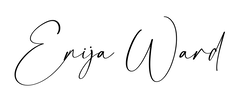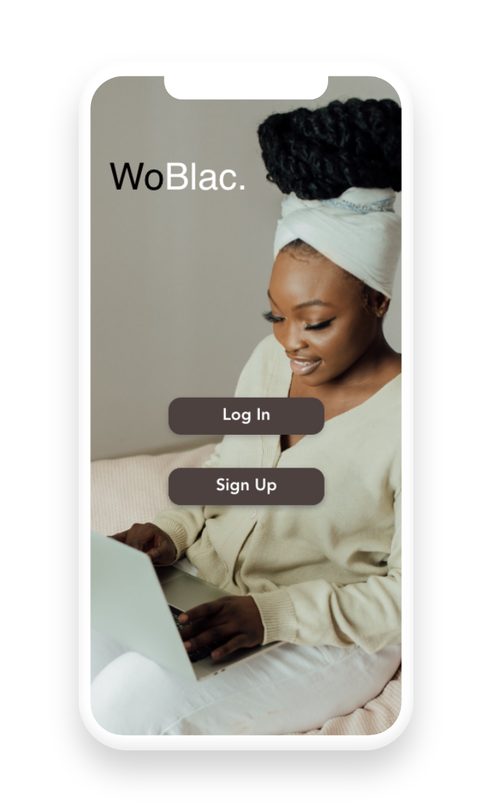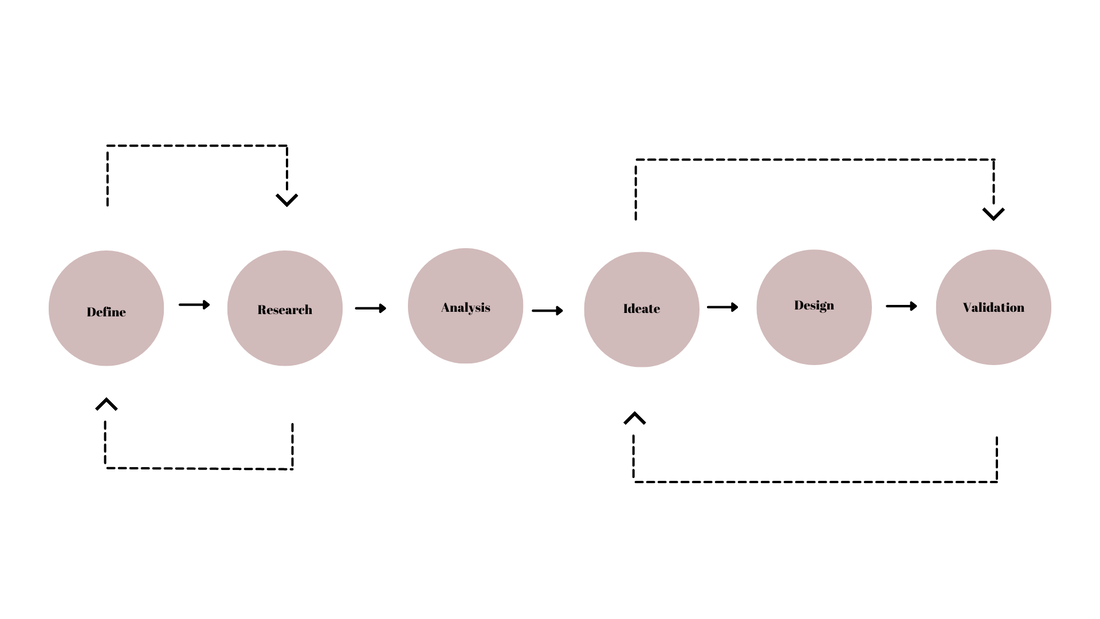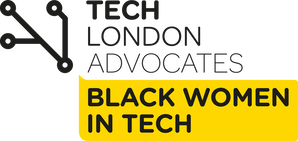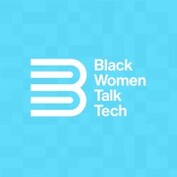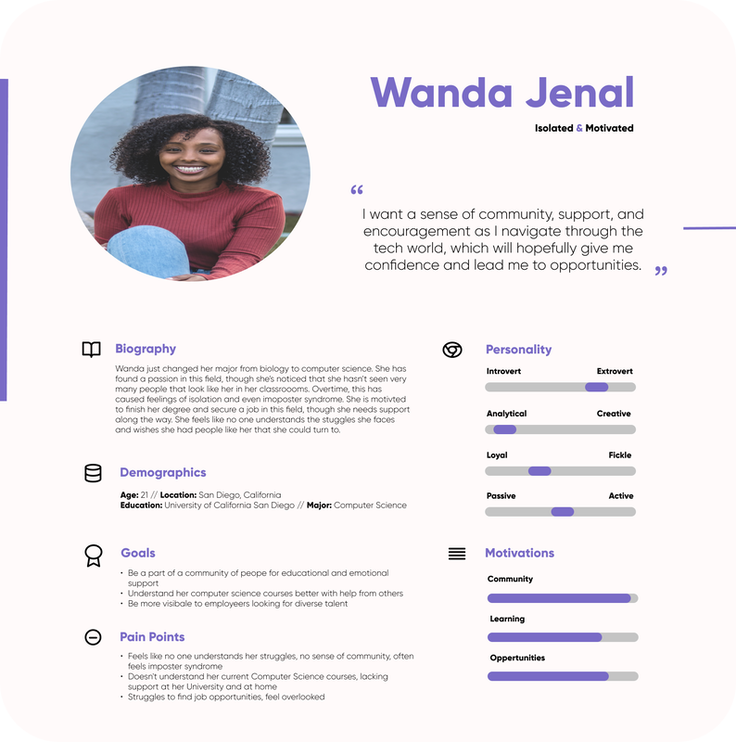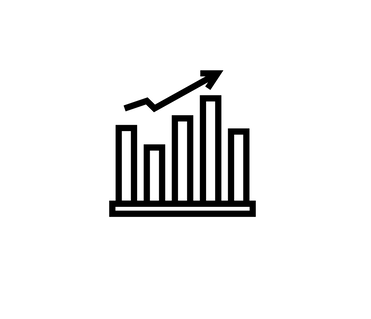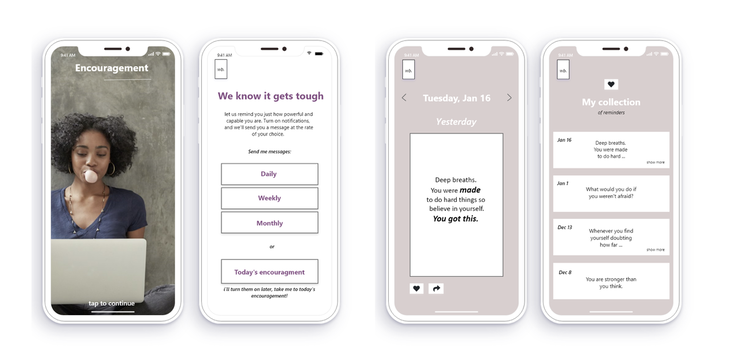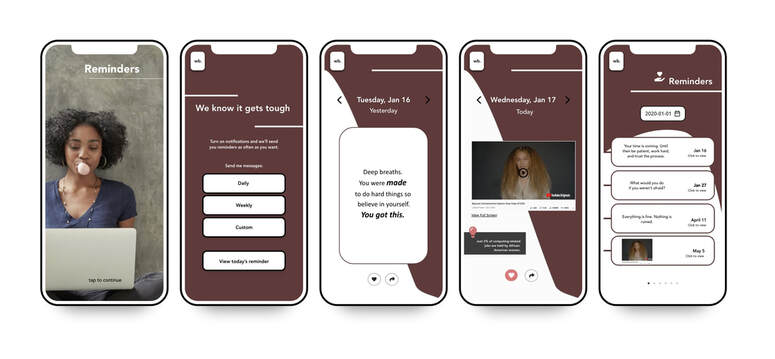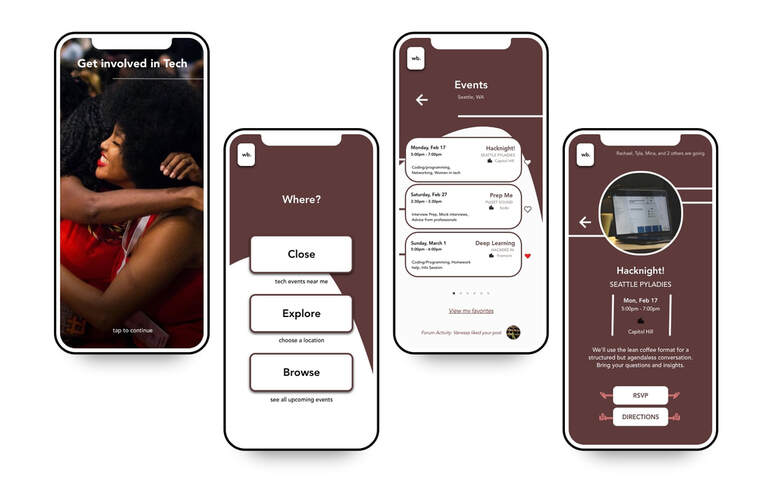OverviewIt's very common to feel isolated and unsupported when pursuing an education in technology as a woman of color. When I started studying tech related disciplines in college, I realized that there weren't many people in my classrooms that looked like me or shared my same experiences. Furthermore, when it came to getting help or guidance, I felt like no one understood what it was like to feel like an outsider while pursuing my degree.
WoBlac. is an individual passion project that rooted from my own struggles as a woman of color in technology, and was created for the support and encouragement of black female students studying in tech. Here, students can create study groups with students from universities across the U.S, discuss pressing and/or interesting topics in the community section, browse black and women tailored tech events, and receive encouragement notifications and reminders to keep going. Users can also build a network of connections and message other users right in the app. |
My Design Process:
Define
What existing problem am I trying to solve? How do I know it's a problem?
The Problem
There's a lack of representation in the tech industry. We see proof of this in the lack of diversity at some of the largest tech companies that we know today like Amazon, Apple, Facebook, Google, and Microsoft which have a women workforce of only about 25%. Furthermore, Black Women account for no more than 6%, making them the least populated in the tech industry - but let's get to the root of the problem.
Tech companies have blamed the education pipeline for gender and racial disparities and some have even invested large amounts to get more high school girls to pursue STEM degrees, though exposure to computer science education alone doesn't automatically result in more girls choosing a career in the field. What's happening along the journey's of those choosing tech and transitioning into post secondary education matters just as much.
African American female students are actually gravitating away from STEM careers by the time they reach college. A study by the U.S Department of Education that looked at those graduating with STEM bachelors degrees examining race/ethnicity showed that African American students only make up 14.9%, and those being black women are only 9.7%. Along with this, they are less likely than their white and asian counterparts to actually land jobs in the field.
Tech companies have blamed the education pipeline for gender and racial disparities and some have even invested large amounts to get more high school girls to pursue STEM degrees, though exposure to computer science education alone doesn't automatically result in more girls choosing a career in the field. What's happening along the journey's of those choosing tech and transitioning into post secondary education matters just as much.
African American female students are actually gravitating away from STEM careers by the time they reach college. A study by the U.S Department of Education that looked at those graduating with STEM bachelors degrees examining race/ethnicity showed that African American students only make up 14.9%, and those being black women are only 9.7%. Along with this, they are less likely than their white and asian counterparts to actually land jobs in the field.
Why should we care? 👩🏾🦱
Representation matters across all media to ensure multiple perspectives and viewpoints are being accounted for and it starts with the people designing, developing, maintaining, and managing the products that are put out into the world. Better representation of marginalized groups is crucial in coming up with the right solutions to challenges, creative thinking, and overall customer success.
Research
What do I know about the primary audience? What already exists that solves the problem?
Method #1: Conversations
I started with low level conversations with people to gauge their experiences and understand their points of view and to confirm that the feelings I had existed outside of my own head. These conversations were very informal where I asked open ended questions like "What's it like being a black women studying in these spaces?" and "What are some of the things you struggle with as a black woman in these spaces?". I talked to four people, and here are the overall trends:
• Mentioned a lack of other women (especially women of color) in their classes
• Sometimes felt discouraged from pursuing these degrees and/or careers after graduation
• Many didn't have family members or friends in tech so couldn't help or offer support
• Math and CS courses were especially difficult, needed additional support with curricular
• Students mentioned major imposter syndrome while pursuing their degrees
• Mentioned a lack of other women (especially women of color) in their classes
• Sometimes felt discouraged from pursuing these degrees and/or careers after graduation
• Many didn't have family members or friends in tech so couldn't help or offer support
• Math and CS courses were especially difficult, needed additional support with curricular
• Students mentioned major imposter syndrome while pursuing their degrees
Method #2: Secondary Research
|
Imposter Syndrome 🙍🏾♀️
In an online study, more than half of women said they have felt like impostors. For Black women, the intersecting challenges of racism and sexism make them even more susceptible to impostor syndrome. A 2020 study found that for black scholars in STEM, gender was one of the many intersecting identities that contributed to feelings of impostor syndrome, with black women often being the only or one of very few in their field.
|
Academic Support & Encouragement 📚
I learned that effective study groups can help students learn course material in a deeper, more concrete way. Groups that are effective generate positive energy, encourage active participation, instill discipline, and require commitments from members. These skills are certainly important for learning.
Some influential black women that are prominent in this community are Michelle Obama, Beyonce, Simone Biles, and plenty more. I could use these influences to send positive messages. |
|
Community Forums 💬
I looked through community threads to gauge other peoples experiences which pretty much echoed everything I was feeling myself and heard in conversations. Many black women in tech were suffering due to lack of support, lack of resources, and/or not understanding class content and wanting to give up.
There are lots of conversations about being black and a woman in technology are on reddit, many separate conversations about the same feelings I've described. |
Language 🗣
I wanted to see how people in this community were conversing like what words they used and how they comforted each other. I had prior knowledge of this from experience being a part of this community myself, though I just wanted to confirm that this language was widely shared.
The words "girl" and "look" were often markers of identity and widely used in the black community. In all, the language was more relaxed and quite different from the corporate talk that many identified as "code switching". |
Method #3: Competitive Analysis
When looking into the competition, I found these two businesses which are both organizations that help support, excel, and connect this community. I’ve noticed the people in these spaces are usually already professionals in the field and are able to talk about things on a high business level.
|
TLA Black Women in Tech
Audience: Black female entrepreneurs
Mobile App: No mobile app Website: Yes, there's a website Events: Yes, events offered Community: Yes, community Study Groups: No study groups Encouragement: No dedicated encouragement component Analysis: This is a great platform for black female professionals looking to build their own business, but there is no support for students or those just starting out. |
Black Women Talk Tech
Audience: Black female experts & entrepreneurs
Mobile App: No mobile app Website: Yes, there's a website Events: Yes, events offered Community: Yes, community Study Groups: No study groups Encouragement: No dedicated encouragement component Analysis: Great platform for professionals, tells stories of black women very well, though no direct support for students. |
This would mean a product made specially for students would be unique from the competition. My product could be made for students specifically to help them succeed and excel so that they can get to those points in their careers and feel confident enough to do things like network, attend events, etc; but the inclusion of a mobile app since neither of these companies currently offer this for their users.
Analysis
I created a persona based off of the research that I did and created some assumptions on things like personality to complete it. I would like to do further research to validate some of the assumptions that I made!
Primary Persona 👩🏽🦱
The primary persona is a college student studying computer science. She loves what she does but needs more support & community while pursuing her degree.
Ideate
What's my proposed solution to the problems I've identified? How does it solve the problem?
Concept
An app for black female students studying for careers in tech. I landed on four central and important components that my target audience would benefit from most:
• Community - A space where students can talk and connect with each other. Here, they can have conversations about hardships they are experiencing or anything else on their minds
• Events - Access to black and/or women tailored tech events to grow their professional skills and immerse themselves in their career spaces of interest while networking
• Study Groups - Students can create and/or join study groups with other students from universities around the United States to get help with the things they are learning in their courses
• Encouragement - This feature will show encouraging quotes, affirmations, and messages from inspirational black women and leaders (or anyone) as encouragement to keep going and pursuing these difficult careers
• Community - A space where students can talk and connect with each other. Here, they can have conversations about hardships they are experiencing or anything else on their minds
• Events - Access to black and/or women tailored tech events to grow their professional skills and immerse themselves in their career spaces of interest while networking
• Study Groups - Students can create and/or join study groups with other students from universities around the United States to get help with the things they are learning in their courses
• Encouragement - This feature will show encouraging quotes, affirmations, and messages from inspirational black women and leaders (or anyone) as encouragement to keep going and pursuing these difficult careers
Product Names 📝
My first thought was to call it something along the lines of "black students in tech" as this was very similar to other products that addressed similar issues in my competitive analysis. I figured having a similar name wasn't super important, so my next thought was to just combine the words women and black. I landed at Woblac which seemed like a short enough name that I could see working well in branding and downloaded as an app on someones phone.
Employer Route 👩🏽💼
When I ran this idea by a diversity recruiter at Facebook who's main goal was to recruit more people of color into tech roles, she mentioned an idea to add a separate employer route. This way, for her and others in her field that were specifically sourcing black talent, she could easily find students through this platform for potential job opportunities. I loved this idea as it's the perfect way to directly address the pain point of there being a lack of opportunities for women of color and a lack of representation jobs and companies. This is something that I have been working on exploring and designing. I still have to talk with more recruiters to figure out how this might function in real time and how I might design to meet the needs on their side as well.
Decisions 📍
One thing I noticed getting push back on was this product only being for women. When I've told men about this idea I've run into the same question: "What about us?". This question is valid, as I know black men struggle with visibility and opportunities as well alongside our white counterparts. Because I kept getting this question, I did ask myself if my product was too limiting and should maybe be designed for black male students as well.
I had to remember who I was designing for. Black women are the least accounted for in the field of tech and we struggle with the most battles because of this. Along with this, black women usually really appreciated that this was a space built for them because of everything they've struggled with and have no answers to. Given this, I decided to keep the audience at black female students instead of trying to solve multiple problems for multiple audiences at once, though I am open to accounting for more audiences in the future!
I had to remember who I was designing for. Black women are the least accounted for in the field of tech and we struggle with the most battles because of this. Along with this, black women usually really appreciated that this was a space built for them because of everything they've struggled with and have no answers to. Given this, I decided to keep the audience at black female students instead of trying to solve multiple problems for multiple audiences at once, though I am open to accounting for more audiences in the future!
|
Product Goals & Success Metrics 🙌
|
Design: Beginning Phases
Iteration #1 😧
This is where it all started. I began trying to put my thoughts into a design with no real UI/UX experience. At this time, I was still studying web development so my understanding of design principles and standards was pretty much non-existent. Nonetheless, I did what I could. That being said, the below might hurt to look at as it definitely looks more like a wireframe than a final version.
Validation: Part One
I was able to get some feedback at this point to help understand where I could improve. At the time, I didn't know anything about usability testing but I did show some screens and asked what people thought about them. Here's some of the feedback:
• Fix the color scheme (inconsistent, not present enough throughout prototype)
• Add more photos for some realism and pop
• Research Interaction Design Principles & Laws to account for them in the designs
• Typography is off - fix spacing, font sizes, font weights, etc.
• Fix the color scheme (inconsistent, not present enough throughout prototype)
• Add more photos for some realism and pop
• Research Interaction Design Principles & Laws to account for them in the designs
• Typography is off - fix spacing, font sizes, font weights, etc.
Iteration #2 😓
I took all of the previous feedback into account and iterated on it again. At this point, I had a little more experience with UX but not much. It looked something like this:
Validation: Part Two
This version of the design didn't last very long or even make it to older versions of my portfolio! I asked for feedback on this pretty much immediately after it was created, and then updated from there based on feedback. Here's the main feedback points:
• Color scheme is dark and not super engaging
• Add interactions and animations to demonstrate experience
• Consider a separate route for employers to further address the lack of opportunities pain point
• Color scheme is dark and not super engaging
• Add interactions and animations to demonstrate experience
• Consider a separate route for employers to further address the lack of opportunities pain point
Design: Current Phase
These are the current designs, further iterations are currently in the works!
Click through the experience below! Please reference captions above each photo for context.
Backlog
Below are some things that are either in the works or to be done that I'm looking forward to exploring to make my product stronger and more suited towards the users needs.
|
Employer Route 👩🏽💼
This route will help employers find black talent and help students get opportunities to directly address that pain point. As mentioned in earlier stages, this is something in the works from some feedback I received from a diversity recruiter at Facebook that expressed deep interest in this as it’s sometimes difficult to find women of color for the roles she’s recruiting for. This feature will help connect students and graduates to job opportunities.
|
More Research & Testing 🔍
I want to do more research to make more informed decisions for this product. As shown, I have had some conversations with people that I know but I want to do more with people outside of my immediate circle to get a larger sample of evidence to support my product and claims. One thing I want to do is visit HBCUs to get insight on the product as it is, it's usefulness, and maybe different considerations I haven't thought of yet. This will ultimately make my product stronger and more accurate as I change things over time based on the research I gather.
|
Reflection
Challenges
The biggest challenge I've faced with this project overall from the beginning was my lack of knowledge about UX. This made the design process pretty messy and unconventional from the start, I didn't know what a design process was or any real fundamentals about design. I've had to go back and refine things and now that I know more, I notice points where things could have maybe moved along faster or made more sense in the moment if I just had the knowledge at that time. Though, seeing this product grow over time and knowing how much more potential it has in growing has been so fulfilling. I'm excited to continue working on it and applying my skills as I learn and grow in this field!
Takeaways
This is one of the first projects that I ever created as a designer, and one of the biggest lessons I learned is that I am not my user! I may be in the target audience myself since it was created for people like me, though what I think users need and what they actually need are completely different things, so really this whole idea behind user-centered design is something I learned the hard way. My first stab at designing this didn't account for the users much at all but the one you guys see now has accounted much more for UX and Interaction Design, with lots of room for improvement in future iterations.
